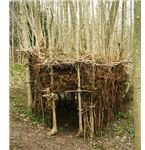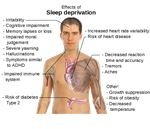Five Basic Survival Needs of Human Beings
-
List of basic human survival needs:
- Oxygen
- Water
- Food
- Shelter
- Sleep
1. Oxygen
 Oxygen is possibly our most basic human need. People can begin to experience brain damage after as few as five minutes without oxygen. There are several things that may prevent you from getting the oxygen you need. Environmental risks such as high amounts of smoke, high altitudes or carbon monoxide can prevent you from breathing in oxygen. Some medical issues may prevent your body from receiving oxygen like cardiac arrest, stroke, drowning and others.
Oxygen is possibly our most basic human need. People can begin to experience brain damage after as few as five minutes without oxygen. There are several things that may prevent you from getting the oxygen you need. Environmental risks such as high amounts of smoke, high altitudes or carbon monoxide can prevent you from breathing in oxygen. Some medical issues may prevent your body from receiving oxygen like cardiac arrest, stroke, drowning and others.Without a consistent supply of oxygen, you can experience a condition called cerebral hypoxia which affects our brains. After 15 minutes without oxygen, the brain damage can be so severe that most people will not recover.
2. Water
Other than the air we breathe, water is the most essential component for human survival. It is estimated that a person cannot survive for more than 3-4 days without water.
In hot weather it is recommended that the average person needs to consume two quarts of water a day to replace the amount lost due to sweating, respiration and excretion to maintain a balance of body fluids. In moderate climates you may be able to get by on less. Some foods can also provide you with water, though you should avoid food and drink that could dehydrate you.
When the hydration balance is unable to be maintained the body will start to go through the dehydration process. A 2.5 percent loss in water volume in a person leads to a 25 percent reduction in blood volume. This means the blood gets thicker and the heart has to work harder to pump nutrients throughout the body. This lower blood volume also reduces flow to the extremities, leading to numbness in the fingers and toes. The thicker blood also has a harder time making its way through the small capillaries in the brain. The lack of oxygen to parts of the brain can make it impossible to concentrate or focus for any period of time.
The length of time one can survive without water depends on activity level and environmental temperature. Higher activity will invariably reduce life span, as will higher temperatures. With no water, the maximum length of time a person can survive is 10 days. Starting at 80 degrees Fahrenheit life expectancy is reduced to 9 days. With every five-degree increase in temperature, the life span decreases a day.
3. Food
 If you have a good water supply the next essential need is that of sustenance. A body that does not have food can survive for quite a long time by subsisting on the fat reserves in the body and, eventually, the glycogen reserves in the liver and the proteins in the muscles.
If you have a good water supply the next essential need is that of sustenance. A body that does not have food can survive for quite a long time by subsisting on the fat reserves in the body and, eventually, the glycogen reserves in the liver and the proteins in the muscles.The first two to three days without food, the body will depend solely on the fat reserves to run the muscles of the body. Unfortunately, these fatty acids can’t cross the blood-brain barrier. The brain relies on the glycogen reserves to send glucose to the brain.
After day three, the liver begins to synthesize ketones (short strand fatty acids) that can cross the blood-brain barrier. The ketone stage can last for up to two weeks. Once the fat reserves are used up, the body will begin breaking down the musculature into proteins that can be converted into amino acids that are then transformed into glucose. Muscles break down quickly, within one week. Once this process has completed there is no other internal source of energy and the body dies.
Most individuals who experience starvation don’t die directly from it. Most die due to infectious diseases that attack the body as it eats its own defenses. Signs of starvation include apathy, listlessness, withdrawal, changes in hair color, flaky skin, and massive edema in the abdomen and lower limbs, all of which lead to a higher chance of infection.
4. Protection from the Elements
 A shelter that helps to keep your body at a constant temperature is also a necessity. This could also include appropriate clothing. When a person is exposed to the elements, water loss is increased. Cold temperatures and high winds can strip away valuable moisture as quickly as high temperatures can cause sweat related loss. A shelter should consist of a place to make fire to create heat as well as protection from the wind and rain.
A shelter that helps to keep your body at a constant temperature is also a necessity. This could also include appropriate clothing. When a person is exposed to the elements, water loss is increased. Cold temperatures and high winds can strip away valuable moisture as quickly as high temperatures can cause sweat related loss. A shelter should consist of a place to make fire to create heat as well as protection from the wind and rain.Without the ability to keep a constant temperature, a person runs the risk of hypothermia or heat stroke. A person’s normal temperature in 98.7 degrees Fahrenheit. If the core temperature drops to 91.4, a body will go unconscious. At 86.0 degrees, the body loses the ability to control internal temperature. At 82.4 degrees, there is complete muscle failure.
On the other end of the spectrum, a temperature of 107.6 degrees results in a breakdown of the central nervous system. At slightly over 111 degrees, the brain overheats and causes death.
Extreme temperature fluctuations can cause hallucinations and illogical behavior, which can cause a person to fail to take the proper steps to keep himself alive.
5. Sleep
 For a long time sleep was not considered a basic human need. Studies on sleep deprivation helped to change this in the 20th century. In terms of human need, sleep is one of the five most important elements. Sleep deprivation can cause a myriad of problems ranging from decreased body temperature to cognitive impairment and hallucination.
For a long time sleep was not considered a basic human need. Studies on sleep deprivation helped to change this in the 20th century. In terms of human need, sleep is one of the five most important elements. Sleep deprivation can cause a myriad of problems ranging from decreased body temperature to cognitive impairment and hallucination.
Although the mechanisms of sleep are not well understood, the problems associated with lack of sleep are. Headaches can begin as soon as 24 hours after missing sleep. 72 hours in, memory is impaired and temporal and spatial distortion start to occur. After 96 hours without sleep, cognition is markedly impaired. After 144 hours, hallucinations ensue and there is a considerable loss of attention and manual dexterity.
The longer a person goes without sleep the less coherent thought patterns become. This lack of clear thinking can be detrimental on its own, if coupled with a lacking in any of the other basic needs areas it could be life threatening.
There are other things you could add to this list like sex, emotional connection, sense of belonging, etc. The difference is that although sex is needed for the species to survive an individual can live without it. Emotional connection and a sense of belonging are group needs, not individual survival needs. The truth is, there are only five basic needs; Clean Air, Water, Nutrients, Shelter and Sleep.
Beyond our health, the simple fact is that our entire society is based primarily on the existence and leveraging of these five factors. They are the basis for concepts like family, wealth, health and, at times, governments. Without air, water, food, sleep or shelter, none of us would see it past our first few days on Earth.
References
- Nuts and Raisins courtesy of Christmas Stock Images.com http://christmasstockimages.com/free/food-dining/slides/nuts_and_rasins.htm
- Water image courtesy of SNAP @ Flickr http://www.flickr.com/photos/snapr/484776493/sizes/m/in/photostream/
- NASA “Human Needs” http://www.nasa.gov/pdf/162514main_Human_Needs.pdf
- “Survival in the Wilderness.” Wilderness Survival Skills for Safe Wilderness Travel. Web. 08 Aug. 2011.http://www.wilderness-survival-skills.com/survival-in-the-wilderness.html
- “Survival Needs – Human.” Water: Science and Issues. Web. 08 Aug. 2011.http://www.waterencyclopedia.com/St-Ts/Survival-Needs.html
- Sleep Deprivation Image – http://en.wikipedia.org/wiki/File:Effects_of_sleep_deprivation.svg
- “Going Without Water | Survival Topics.” Survival Topics | Your Online Survival Kit! Web. http://www.wilderness-survival-skills.com/going-without-water.html
- Shelter Image courtesy of DominicsPics @ FlickRhttp://www.flickr.com/photos/dominicspics/3400028576/sizes/m/in/photostream/
- Cerebral hypoxia – http://www.healthcentral.com/ency/408/001435.html?ic=506048
